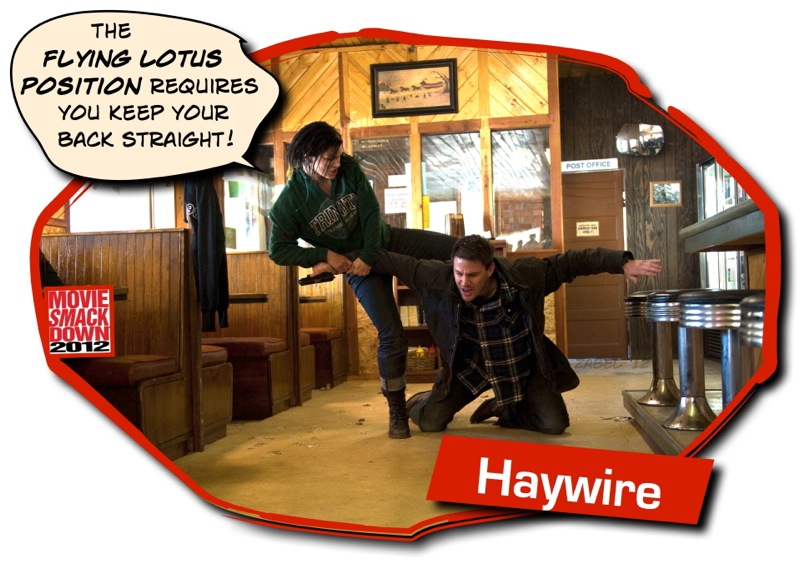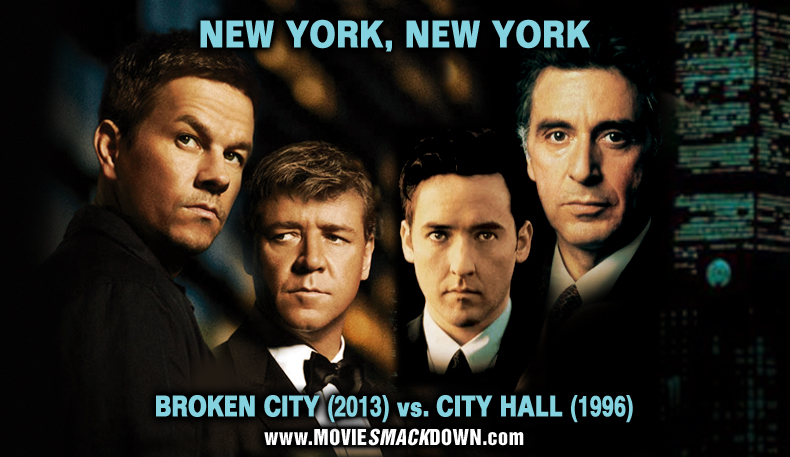
The Smackdown
“All you need for a film is a girl and a gun.”
– Jean-Luc Godard
Well, and film, I reckon, but Jean-Luc’s point is well taken, and this Smackdown brings us two movies that attempt to put it to the test.
In this corner, a comely mixed martial arts champion making her screen acting debut.
And in this corner…Screw it, you know her already.
Ding!
 The Challenger
The Challenger
Indie godfather and Man of a Thousand Projects Steven Soderbergh tackles another genre with Haywire, a straight-ahead action thriller that he seasons with his usual tics (quick insert shots, flashbacks, audacious color and lighting choices, etc.) and crowns with the sizable gamble of casting Gina Carano, a twenty-nine-year-old MMA fighter with no previous acting experience, in the lead. His last experiment along these lines was hiring porn star Sasha Grey for the lead role in the dreary Girlfriend Experience, but the significant difference here is that Carano’s talents are actually put to use for her role. (Grey’s talents were nowhere in evidence and remained relegated to approximately one-third of the Internet.)
Carano plays Mallory Kane, an expert and white-hot covert operative who works for weaselly Ewan MacGregor (as usual, Soderbergh crams the supporting roles with familiar faces working for a fraction of their normal asking price). She takes on a gunplay-heavy hostage extraction assignment in Barcelona, which then segues into a simple “eye candy†job in Dublin that has her posing as the companion of colleague Michael Fassbender at a ritzy party. But when she is revealed (in arguably the best of several exhausting hand-to-hand combat setpieces) to be the real target, she finds herself on the globe-hopping, adrenaline-fueled run, hoping to clear her name and exact revenge on whoever ordered the hit, unable to trust anyone but her loving dad (Bill Paxton).
 The Defending Champion
The Defending Champion
Oscar-winning actress/geek goddess/saint Angelina Jolie plays the title role in Phillip Noyce’s Salt (2010), a conspiracy thriller so twisty that it defies description, which is wise on its part, since description would only serve to illustrate how nonsensical it is. But for starters: Evelyn Salt, America’s sultriest CIA agent, is named by a rather specious defector named Orlov (Daniel Olbrychski) as a Soviet mole. She responds to this by making an abrupt getaway, which tips off her superiors that Orlov wasn’t just talking out of his ushanka.
It turns out Salt was indeed trained and groomed to infiltrate the CIA and be just generally superhuman, and she is now on the lam and preparing her next mission, assassinating the Russian vice president during a visit to the States, in order to rekindle Russia’s anti-U.S. sentiments and provoke an attack. Or something. But has she changed her sympathies over the years so that she’s now only feigning her anti-American efforts in hopes of outing a fellow mole? To say more would risk spoilers. Plus I’m not entirely sure I’d get it right; it’s hella confusing. Anyway, there’s lots of chases and shootings and fights and stuff. That’s the main thing.
The Scorecard
As we left the Haywire screening, I asked my companion whether or not a key question in the plot had ever been addressed. She confirmed it hadn’t, and it is perhaps a testament to the movie’s assets that neither of us really minded. The main assets in question being a) five or six really well choreographed, just plain kick-ass fight scenes between Carano and a variety of sculpted leading men (current “It†guy Channing Tatum among them); and b) Carano herself, who is a real find, a genuinely remarkable physical specimen who does all her own stunts and convincingly kicks said asses of said leading men. Whether she has acting capabilities beyond this sort of thing is unknown, but she is utterly likable, seems equally comfortable in sportswear and evening wear, and delivers her lines capably (though apparently not without post-production assistance). Whatever one thinks of the film, clearly Soderbergh’s instincts for his leading lady were dead on.
Additional perks include one of David Holmes’ typically infectious scores, minor but effective support from the likes of Paxton, Michael Douglas and Antonio Banderas, the usual expert camera-work by Soderbergh himself (as always, under the pseudonym Peter Andrews), and some hair-raising chase scenes—one on foot via rooftops and one through the woods via car, largely in reverse. Admittedly, none of it adds up to much, and it probably ranks somewhere in the lower mid-region of Soderbergh’s directorial efforts; as compared to his other collaborations with screenwriter Lem Dobbs, it is significantly less intriguing than The Limey, for instance, but far more fun than Kafka. But it’s an exhilarating ride while it lasts, worlds better than most January junk, and if nothing else, an ideal audition reel for Carano if they ever get that Wonder Woman feature going.
Where the modest, efficient Haywire was able to convince me that its plot was of minor importance, the much more ambitious, summer blockbusterish Salt fooled me into thinking it would all make sense by the time the credits rolled, and when it didn’t, I was left with a bad, salty aftertaste. It’s not that a shoot-’em-up like this isn’t allowed a few plot-holes or contrivances, provided that its other aspects compensate for them. But once you reach the end and give the story a moment’s scrutiny, none of it holds together.
It’s difficult to discuss a lot of these issues without spoilage, but let’s just take the inciting incident as an example, wherein Orlov outs Salt as a mole. This leads to a suspenseful chase scene (capably directed by Noyce, best known for the two Harrison Ford “Jack Ryan†flicks) that has Salt outrunning a gang of CIA agents (including the ever-reliable Liev Schreiber) and barely escaping with her life. We soon learn that Orlov, who escapes custody, is in cahoots with Salt and did this deliberately as part of the plan (and whether or not she knew this was part of the plan is up for debate). So he risks her capture and/or her life, risks throwing decades of training down the drain… why, exactly? The answer never comes; the filmmakers simply hope that by the end, you’ve forgotten the question.
The script is credited to Kurt Wimmer, a talented director himself (check out the ultra-cool futuristic thriller Equilibrium), and one can’t help but suspect it suffered heavily from studio interference; at the very least, it underwent some heavy reworking, seeing as this was originally a project for Tom Cruise. Jolie is a solid (and slightly less nutty) substitution; I’ve always found her looks a bit too synthetic to fully accept her as an actress, and most of her filmography to range from the forgettable to the risible, but she’s put to good use here as essentially a comic-book heroine. Honestly, it’s hard to fault the performances, the action sequences, the technical credits or anything else about Salt beyond its exasperating, lazy mess of a story. The ending sets up a sequel, which I gather is still in the works, so perhaps the myriad of questions one is left with will be answered in Salt II: The Treaty… but I’ll decline to hold my breath on that.
The Decision
Okay, no, neither of these movies exactly belongs on your bucket list. Both are dispensable, mindless and fairly enjoyable roller coaster rides, provided that your brain is switched to “off.†The difference is mainly one of attitude: Where Haywire all but freely admits that its plot doesn’t matter, Salt either genuinely thinks it makes sense or thinks it can convince you that it does. Either way, it’s wrong. Haywire doesn’t even try to be anything more than it is, namely a clothesline for some ass-kicking fight scenes and a showcase for the fresh-faced Carano, who proves herself, if not necessarily a great actress, a striking screen presence with the physique, adroitness and likability to appeal to both genders. Jolie, of course, is no slouch in that department either, and in fact, her expertise as an action hero helps make Salt almost good enough to forgive its flaws, but ultimately, I came away from it too annoyed to feel quite satisfied. As sure as Mallory Kane could flatten Evelyn Salt with one roundhouse kick, so too do we declare Haywire the winner of this sexy, chop-socky Smackdown, albeit in a close decision. For a double feature, you could do a lot worse.





I thought Gina Carano was terrific — likeable, poised, credible in her role, and above all, one of the most convincingly realistic martial-arts action stars I’ve ever seen, male or female. Her type of fighting is a refreshing change from the highly stylized, visually driven choreography routines we’re usually treated to. Salt was the flashier, slicker movie (in the James Bond vein), but in the end I cared more about what happened to Mallory Kane than about what happened to Evelyn Salt, which is a testament to Carano’s relatability. As for Haywire’s plot and what Michael Douglas’s fundamental agenda was … well, best not to linger on those for too long and just enjoy the ride. Anyway, I’d never heard of Carano before I saw this flick, and she came as a very pleasant surprise.
Rosie, I’ll concede that of the two, Jolie is the better actress in general, but Carano still makes the better action hero. Maybe it’s partially that Jolie is so thin in “Salt” that she looks like if she merely tripped over a shoelace, her entire body would shatter.
I will also concede that I would have rather been watching Michelle Yeoh and Zhang Ziyi kick ass than either of these movies, or Maggie Q for that matter.
Not sure what that has to do with anything, but there you have it.
Are you kidding me? “HAYWIRE” beats “SALT”? “SALT” may not be the world’s greatest action movie, but it has a decent plot and Angelina Jolie is ten times a better actress than Gina Carano. And that is all that matters to me. I couldn’t care if Carano was a former martial arts fighter or whatever. Michelle Yeoh and Zhing Zyi are better and they are basically dancers, not martial fighters.